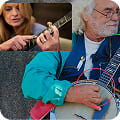Classical Clarinet School with Ricardo Morales
Preview this school
Master the Instrument with Ricardo
Each lesson builds on the last, taking you from zero to hero!
As Principal Clarinet of The Philadelphia Orchestra since 2003, Ricardo Morales is one of the most respected names in classical music. He played with the Metropolitan Opera Orchestra from 1993-2003, where he was appointed Principal Clarinet at the age of 21. Ricardo Morales has played clarinet with The Chicago Symphony, The New York Philharmonic, as well as the Berlin Philharmonic and the Kinen Orchestra in Japan. Ricardo Morales has won many awards including Grand Prize at the Seventeen Magazine National Concerto Competition, First Prize in the national Arts Recognition and Talent Search, and he was named a Presidential Scholar in the Arts by President Bush. As an educator, Ricardo serves on the faculties of The Juilliard School, Temple University and the Curtis Institute of Music, and has been giving clarinet master classes for years at many classical conservatories and institutions. Aside from teaching clarinet lessons online at ArtistWorks, Ricardo continues to perform and collaborate with a wide range of chamber musicians. His debut solo recording, French Portraits, was released in 2004 on Boston Records and his most recording with the Pacifica Quartet was nominated for a Latin Grammy Award.
Fundamentals
Etudes
Orchestral Repertoire
Solo Repertoire
30 Day Challenge
Lessons Intro
Get Personal Feedback with Video Exchange
Get custom video lessons from your instructor by sending a video of your playing.
How It Works?

1. Submit Your Video
Record and upload directly through our platform. No technical skills required.

2. Get Expert Feedback
Receive personal video responses from Ricardo Morales with tips to improve!

3. Learn from Community
Browse exchanges from other students to learn from their questions.
About Classical Clarinet School with Ricardo Morales
As Principal Clarinet of The Philadelphia Orchestra since 2003, Ricardo Morales is one of the most respected names in classical music. He played with the Metropolitan Opera Orchestra from 1993-2003, where he was appointed Principal Clarinet at the age of 21. Ricardo Morales has played clarinet with The Chicago Symphony, The New York Philharmonic, as well as the Berlin Philharmonic and the Kinen Orchestra in Japan. Ricardo Morales has won many awards including Grand Prize at the Seventeen Magazine National Concerto Competition, First Prize in the national Arts Recognition and Talent Search, and he was named a Presidential Scholar in the Arts by President Bush. As an educator, Ricardo serves on the faculties of The Juilliard School, Temple University and the Curtis Institute of Music, and has been giving clarinet master classes for years at many classical conservatories and institutions. Aside from teaching clarinet lessons online at ArtistWorks, Ricardo continues to perform and collaborate with a wide range of chamber musicians. His debut solo recording, French Portraits, was released in 2004 on Boston Records and his most recording with the Pacifica Quartet was nominated for a Latin Grammy Award.
About Ricardo Morales
As Principal Clarinet of The Philadelphia Orchestra since 2003, Ricardo Morales is one of the most respected names in classical music. He played with the Metropolitan Opera Orchestra from 1993-2003, where he was appointed Principal Clarinet at the age of 21. Ricardo Morales has played clarinet with The Chicago Symphony, The New York Philharmonic, as well as the Berlin Philharmonic and the Kinen Orchestra in Japan. Ricardo Morales has won many awards including Grand Prize at the Seventeen Magazine National Concerto Competition, First Prize in the national Arts Recognition and Talent Search, and he was named a Presidential Scholar in the Arts by President Bush. As an educator, Ricardo serves on the faculties of The Juilliard School, Temple University and the Curtis Institute of Music, and has been giving clarinet master classes for years at many classical conservatories and institutions. Aside from teaching clarinet lessons online at ArtistWorks, Ricardo continues to perform and collaborate with a wide range of chamber musicians. His debut solo recording, French Portraits, was released in 2004 on Boston Records and his most recording with the Pacifica Quartet was nominated for a Latin Grammy Award.
What students are saying!
Clarinet
I e8njoy maestro Ricardo classes very much

